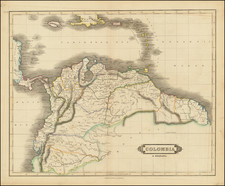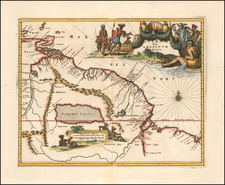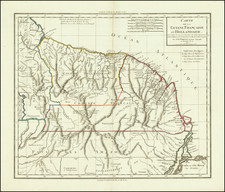Hand Drawn Map of Sugar Plantations / Essequibo Coast / Apprentice Labourers
Interesting cadastral map showing the Sugar Plantations at the mouth of the Essequibo River in the Parish of St. Johns in British Guiana, illustrating the local population of "Apprentice Labourers" following the enactment of the Emancipation Act of 1833.
The present map was created shortly after the effective date of the Act, August 1, 1835, at which time the slave population of British Guiana became apprentice labourers, with a pathway to complete freedom over the next 3 to 5 years. Enacted with an eye toward the conversion of the slaves to Christianity, the map illustrates the first activities of the Wesleyan Missionaries on this short stretch of the west coast of the Essequibo River, including the location of the "proposed Wesley Chapel" at Abram's Zuil, the first Missionary Chapel in the area that would become known by Missionaries as "Essequebo" District in the 1830s and 1840s.
Orientied with west at the top, the map shows a number of small settlements on a stretch of the Essequibo River, opposite Tiger Island, with a portion of Wakenaam Island in the lower left corner. At the top of the map, two notes reference "about 1300 Apprenticed Labourers to the south of the Church" and "about 2600 Apprenticed Labourers to the North of the Church." Includes the names of a the Sugar Plantations, the sizes acres, locations of buildings, several docks, a church and other details. Across the River, on Tiger Island, the map also shows three estates, Sopienburg, Hamburg and Hoff-Van–Holland.
We were able to identify the following plantations, among others named, with a number of other names not deciphered (the names in bold letters are constabulary districts).
- Aurora District: Spring Garden, Good Hope, Aurora, Hibernia, Fairfield ("), Dry???, Vilvoorden, Middlesex,
- Capoey District: Cullen, Abram, Zuil, Annandale; Zorg-en-Vlyt ; Hoff-van-Aurich; Union;
- Suddie District: Huis t’Dieren, Tiger Island; Adventure, Onderneeming; Belfield; Maria’s Lodge; Zorg; Golden Fleece, Perseverance
The map can best be dated by the note "proposed Westey Chapel," "the first chapel built on the west coast of the river Essequibo . . " Located at what was "Formerly . . . known as Abram's Zuill Circult, the mission wa commenced by Rev. Richard Hornabrook in the year 1836." As noted by Moister:
ESSEQUIBO is now the name given to a Circuit which was formerly known as Abram Zuil, on what is called the Arabian Coast, in a rural district, on the west of the Essequibo river. The Mission was commenced by the Rev. Richard Hornabrook in the year 1836, and has exerted a very beneficial influence in that part of the country. Out-stations were ultimately established at Zorg, Queen's Town, Ebenezer, Anna Regina, Daniel's Town, and more recently on the island of Wakenaam. At some of these places chapels have been erected, and schools esta lished whilst at others strenuous efforts are being made to supply what is wanting to give stability and permanence to the good work.
A second church can be seen opposite the north part of Tiger Island on the coastal side of the Adventures Sugar Mill. This would almost certainly be the location of the St. John Anglican Church, from which the Parish of St. John draws its name. The St. John Anglican church remains in the same location today.
The Emancipation Act and Apprentice Labor in British Guiana
The Emancipation Act of 1833 established a six year Apprenticeship which was designed to serve as a transition period. During this time, plantation owners would retain indentured labor as a part of the compensation due them for the ultimate loss of slave property, the Colonial Office would be given sufficent time to establish the legal framework for the newly free slaves and the missionaries would enjoy six years to save souls, enlarge minds, and bring the apprentices into harmony with the precepts of Christian society.
Two types of apprentices were created. Apprentices who worked in non-farming capacities were awarded freedom in 1838, while aricultural laborers would remain apprentices until 1840.
Overseen by Lieutenant Governor Sir James Carmichael Smyth, a major general in the Royal Engineers, emancipation commenced on August 1, 1835, emancipation commenced, but by August 4, 1835, the apprentices on the Essequibo coast refused to do more than a traditonal half day's work. Lt. Governor Smyth traveled to the region and worked to pursuade the apprentice population to accept a 45 hour work week, under threat of prosecution by the local constabulatory









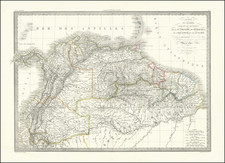
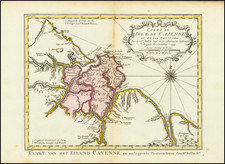
![[ El Dorado! ] Guiana in Guianam & Caribanam divisa. Per N. Sanson](https://storage.googleapis.com/raremaps/img/small/97909.jpg)
